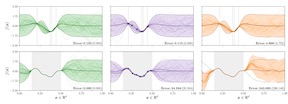|
Test of Time Award
|
Many applications require optimizing an unknown, noisy function that is expensive to evaluate. We formalize this task as a multiarmed bandit problem, where the payoff function is either sampled from a Gaussian process (GP) or has low RKHS norm. We resolve the important open problem of deriving regret bounds for this setting, which imply novel convergence rates for GP optimization. We analyze GP-UCB, an intuitive upper-confidence based algorithm, and bound its cumulative regret in terms of maximal information gain, establishing a novel connection between GP optimization and experimental design. Moreover, by bounding the latter in terms of operator spectra, we obtain explicit sublinear regret bounds for many commonly used covariance functions. In some important cases, our bounds have surprisingly weak dependence on the dimensionality. In our experiments on real sensor data, GP-UCB compares favorably with other heuristical GP optimization approaches. |
|
Outstanding Paper
|
[ Virtual ] 
Learning from unordered sets is a fundamental learning setup, which is attracting increasing attention. Research in this area has focused on the case where elements of the set are represented by feature vectors, and far less emphasis has been given to the common case where set elements themselves adhere to certain symmetries. That case is relevant to numerous applications, from deblurring image bursts to multi-view 3D shape recognition and reconstruction. In this paper, we present a principled approach to learning sets of general symmetric elements. We first characterize the space of linear layers that are equivariant both to element reordering and to the inherent symmetries of elements, like translation in the case of images. We further show that networks that are composed of these layers, called Deep Sets for Symmetric elements layers (DSS), are universal approximators of both invariant and equivariant functions. DSS layers are also straightforward to implement. Finally, we show that they improve over existing set-learning architectures in a series of experiments with images, graphs, and point-clouds. |
|
Outstanding Paper
|
[ Virtual ] 
Plug-and-play (PnP) is a non-convex framework that combines ADMM or other proximal algorithms with advanced denoiser priors. Recently, PnP has achieved great empirical success, especially with the integration of deep learning-based denoisers. However, a key problem of PnP based approaches is that they require manual parameter tweaking. It is necessary to obtain high-quality results across the high discrepancy in terms of imaging conditions and varying scene content. In this work, we present a tuning-free PnP proximal algorithm, which can automatically determine the internal parameters including the penalty parameter, the denoising strength and the terminal time. A key part of our approach is to develop a policy network for automatic search of parameters, which can be effectively learned via mixed model-free and model-based deep reinforcement learning. We demonstrate, through numerical and visual experiments, that the learned policy can customize different parameters for different states, and often more efficient and effective than existing handcrafted criteria. Moreover, we discuss the practical considerations of the plugged denoisers, which together with our learned policy yield state-of-the-art results. This is prevalent on both linear and nonlinear exemplary inverse imaging problems, and in particular, we show promising results on Compressed Sensing MRI and phase retrieval. |
|
Outstanding Paper Honorable Mention
|

Gaussian processes are the gold standard for many real-world modeling problems, especially in cases where a model's success hinges upon its ability to faithfully represent predictive uncertainty. These problems typically exist as parts of larger frameworks, wherein quantities of interest are ultimately defined by integrating over posterior distributions. These quantities are frequently intractable, motivating the use of Monte Carlo methods. Despite substantial progress in scaling up Gaussian processes to large training sets, methods for accurately generating draws from their posterior distributions still scale cubically in the number of test locations. We identify a decomposition of Gaussian processes that naturally lends itself to scalable sampling by separating out the prior from the data. Building off of this factorization, we propose an easy-to-use and general-purpose approach for fast posterior sampling, which seamlessly pairs with sparse approximations to afford scalability both during training and at test time. In a series of experiments designed to test competing sampling schemes' statistical properties and practical ramifications, we demonstrate how decoupled sample paths accurately represent Gaussian process posteriors at a fraction of the usual cost. |
|
Outstanding Paper Honorable Mention
|

Inspired by progress in unsupervised representation learning for natural language, we examine whether similar models can learn useful representations for images. We train a sequence Transformer to auto-regressively predict pixels, without incorporating knowledge of the 2D input structure. Despite training on low-resolution ImageNet without labels, we find that a GPT-2 scale model learns strong image representations as measured by linear probing, fine-tuning, and low-data classification. On CIFAR-10, we achieve 96.3% accuracy with a linear probe, outperforming a supervised Wide ResNet, and 99.0% accuracy with full fine-tuning, matching the top supervised pre-trained models. We are also competitive with self-supervised benchmarks on ImageNet when substituting pixels for a VQVAE encoding, achieving 69.0% top-1 accuracy on a linear probe of our features. |